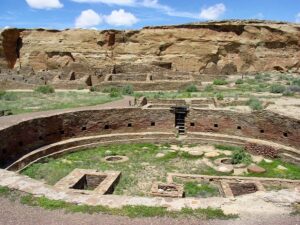Major developments in astronomy, art and engineering were spawned there by early Native Americans
by Brian Vuillemenot
 In a remote canyon in northwest New Mexico lies the center of ancestral Puebloan culture and the largest pre-Columbian ruin north of Mexico. Chaco Canyon served as a cultural, administrative, and economic hub for the peoples of the Four Corners region from approximately 850 until 1250 AD. Major developments in astronomy, art, engineering, and architecture were spawned there.
In a remote canyon in northwest New Mexico lies the center of ancestral Puebloan culture and the largest pre-Columbian ruin north of Mexico. Chaco Canyon served as a cultural, administrative, and economic hub for the peoples of the Four Corners region from approximately 850 until 1250 AD. Major developments in astronomy, art, engineering, and architecture were spawned there.
New masonry techniques allowed for the construction of multiple story great houses. Pueblo Bonito, the largest of the great houses, had over 600 rooms and 40 kivas. These elaborately planned buildings, which took many decades of coordinated effort to complete, demonstrate a deep understanding of the natural cycles of the earth. The back wall of Pueblo Bonito is aligned on a perfect east-west axis. On the summer solstice, the sun passes directly over this wall. Perfectly straight roads that originate in Chaco Canyon emanate out for many miles to other ancestral Puebloan sites. Many examples of astronomical knowledge have been found in Chaco Canyon. On top of Fajada Butte, a crack in the rock wall is aligned with a spiral petroglyph so that sunlight shining through will be perfectly centered on the summer solstice. Sunlight penetrating a window in Pueblo Bonito aligns with an inside corner of the building perfectly on the winter solstice. In addition, several petroglyphs have been found depicting astronomical events, such as the great supernova of 1054 AD. Although Chacoan culture flourished for 400 years, these people left the area towards the end of the 13th century. Several causes may have contributed to this exodus, but the exact reason remains one of the great mysteries of archeology.
Chaco Culture National Historic Park preserves the irreplacable remains of this culture, and was designated a World Heritage site by the United Nations for the priceless cultural resources contained there. The entrance to the park is located 21 miles off of Highway 550/44 south of Farmington. Signs will direct you to the access road, consisting of five paved miles followed by 16 miles of unpaved road. The road is usually smooth enough to be passed by any two wheel drive vehicle, but can be rough in spots. Be sure to call ahead for road conditions if you are in doubt about the worthiness of your vehicle. Although the road can be an inconvenience, the fact that it keeps the park relatively uncrowded more than makes up for it. Once inside the park, the road is paved. The park can also be accessed from the south off of Interstate 40, although the dirt road is longer and rougher.
If you plan on staying overnight, there is a campground to the left of the road before the visitor center. This is the only accommodation within two hours of the park, and may fill up during weekends in spring and fall. The visitor center has exhibits about Chacoan Culture, and rangers there can give advice about what to see. Be sure to register for a free permit if you want to hike any of the trails off of the main road. My favorite hike is the Pueblo Alto loop. After a steep quarter mile, you walk along the mesa overlooking Pueblo Bonito for a spectacular panoramic view. Pueblo Alto lies about two miles farther on the mesa, passed an ancient stairway.
An eight mile loop road, open from sunrise until sunset, will take you to many of the main ruins. In contrast to more crowded parks, such as Mesa Verde, visitors have free access to explore many of the ruins. At Pueblo Bonito, you can enter the rooms through small doorways and contemplate what life was like during the Chacoan era. Chaco Canyon also has some of the darkest skies in North America, making it an ideal place for stargazing. The park observatory is open to the public several times a year. Looking up to the sky and contemplating the meaning of it all is the perfect way to end your day in this enchanting place.
Copyright 2004, Brian Vuillemenot. All rights reserved.
About the author:
Brian Vuillemenot is a scientifically trained outdoor adventurer and photographer specializing in large format and panoramic images of the American southwest. To see more of his work, including images of Chaco Canyon, visit his website at: http://www.imagesofenchantment.com